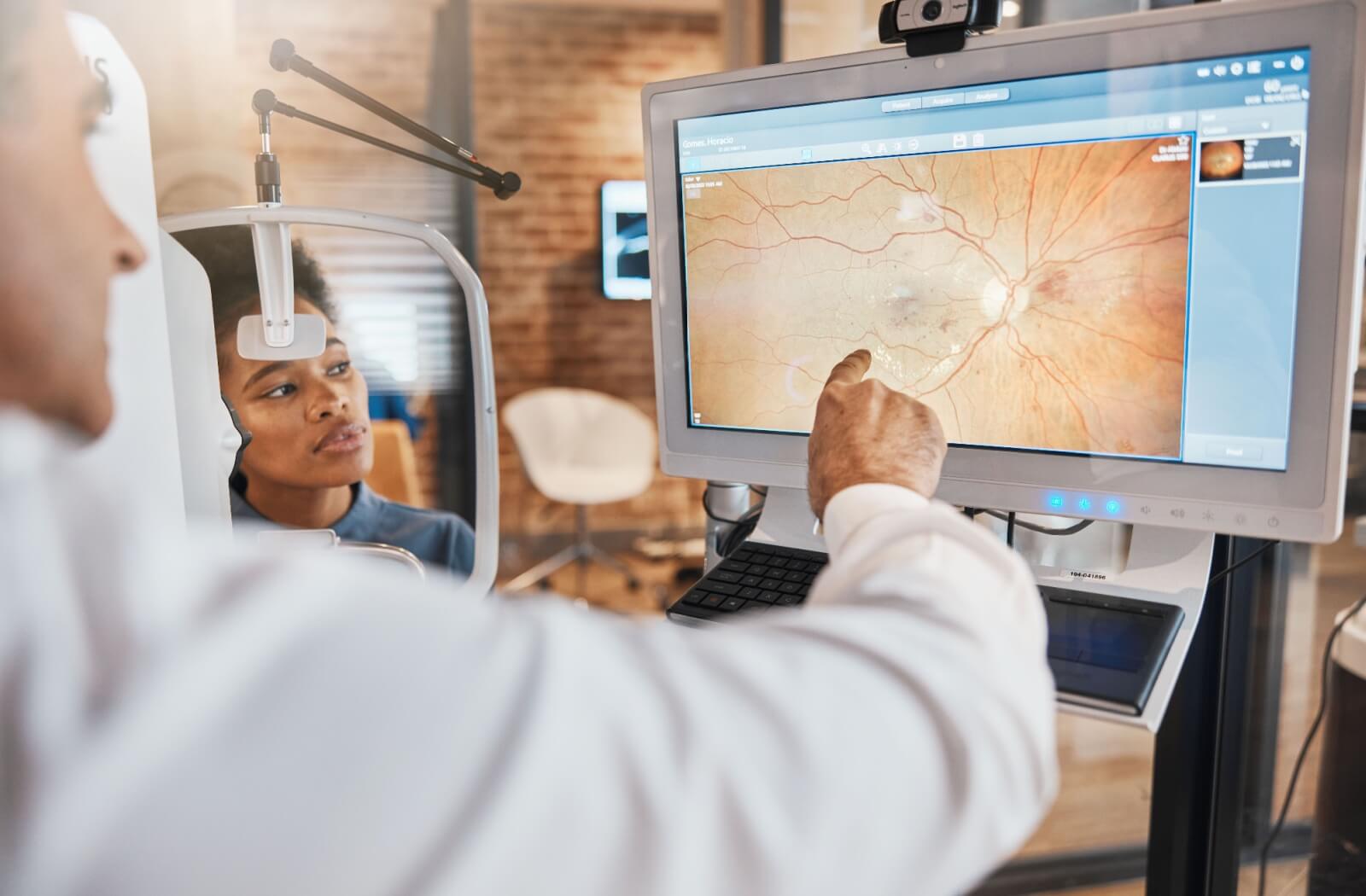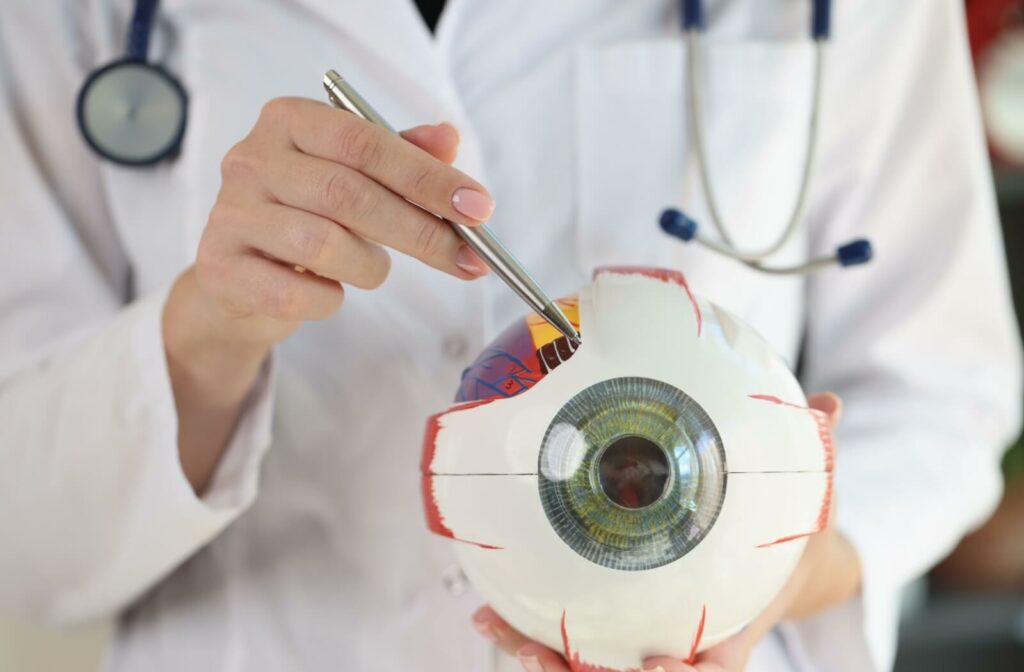Comprehensive eye exams go beyond assessing your vision; they also evaluate the health of your eyes. These exams can detect not only the onset of ocular diseases, but also general health conditions.
Eye diseases that can be detected during an exam include:
- Age-related Macular Degeneration
- Cataracts
- Diabetic Retinopathy
- Glaucoma
Some general eye conditions that can be detected during an exam include:
- Diabetes
- Heart Disease
- High Blood Pressure
- High Cholesterol
- Thyroid Disease
Importance of Routine Eye Exams
Children, adults, and seniors should have routine eye exams once a year to maintain healthy vision and ocular health.
A complete eye exam is recommended at age 40. This is when early signs of disease or vision changes may appear. Annual exams are especially important for those 65 and over, as aging increases the risk of developing certain vision problems.
Eye Diseases
Eye exams can detect several eye diseases and eye conditions. Routine visits to your optometrist will help detect the onset of these conditions early.
Age-related Macular Degeneration (AMD)
AMD is characterized by damage to the macula, the central part of the retina, leading to gradual central vision loss. There are two different types of AMD:
- Dry AMD: Occurs when the macula thins over time as part of the aging process, leading to gradual vision loss. This form is more common and progresses more slowly.
- Wet AMD: Occurs when abnormal blood vessels grow under the retina and macula. These blood vessels can leak fluid or blood, leading to scarring of the macula and significant central vision loss. Wet AMD is less common, more severe, and progresses rapidly.
Both types of AMD primarily affect central vision, which is crucial for activities like reading, driving, and recognizing faces. Early symptoms may include blurry vision, dark or empty areas in the center of vision, and difficulty seeing in low light.
An eye exam can identify AMD early. The Amsler Grid Test assesses vision distortion, a common symptom. A dilated eye exam, followed by a slit-lamp exam, allows your optometrist to examine the macula for signs of AMD and drusen, while retinal imaging and OCT scans provide detailed cross-sectional images of the retina.
While there is currently no cure for macular degeneration, various treatments can help manage the condition and slow its progression.
Cataracts
Cataracts are a common eye disease in which the natural lens of the eye becomes cloudy, scattering light as it passes through the lens. This results in blurry vision, glare, and difficulty seeing at night. Colors may appear faded, while reading or other activities that require clear vision becomes challenging.
Cataracts require surgical intervention to remove the clouding around the lens. If left untreated, cataracts can lead to severe vision loss.
During your routine eye exam, your optometrist will perform a visual acuity test to assess your visual clarity, as well as a slit-lamp examination to get a magnified view of the front of your eye. Both can identify cloudiness in the lens.. Retinal images and OCT scans will show how far the cataracts have progressed.

Diabetic Retinopathy
Diabetic retinopathy is a serious eye condition that occurs as a result of complications from diabetes, where high blood sugar levels cause damage to the blood vessels in the retina. This condition can affect both type 1 and type 2 diabetes patients.
Without timely management, diabetic retinopathy can lead to severe vision impairment.
Diabetic retinopathy impacts vision in stages. First, the tiny blood vessels in the retina weaken, causing them to leak blood and fluid. This leakage can lead to retinal swelling, known as macular edema, which distorts central vision.
As the condition progresses, new, abnormal blood vessels grow on the surface of the retina. These vessels are fragile and prone to bleeding, leading to vitreous hemorrhage and retinal detachment.
A dilated eye exam can detect diabetic changes to the eye. Your optometrist will look for signs of abnormal blood vessels, retinal swelling, microaneurysms, and hemorrhages using retinal imaging, OCT scans, slit lamp examination, and Fluorescein Angiography.
Individuals with type 1 or type 2 diabetes are encouraged to have an annual diabetic eye exam.
Glaucoma
Glaucoma is a group of eye diseases characterized by damage to the optic nerve, often due to high pressure in the eye. This high pressure can cause damage to the optic nerve, which is responsible for transmitting visual information from the eye to the brain.
If left untreated, glaucoma can lead to permanent vision loss. Regular eye exams are vital for detecting glaucoma early, as it often has no symptoms in its initial stages. As glaucoma progresses, individuals may experience a loss of peripheral vision.
A tonometry test measures the pressure inside the eye, indicating whether it’s higher than normal. A visual field test assesses peripheral vision, and OCT scans and retinal imaging capture detailed images of the optic nerve, helping to identify early signs of damage.
Currently, there is no cure for glaucoma. However, the condition can be managed and its progression can be slowed significantly through various treatments to protect vision and prevent further damage to the optic nerve.
General Health Conditions
In addition to detecting eye diseases, routine eye exams can also uncover general health conditions that can also have effects on the eye. These general health conditions can include:
- Diabetes: Signs of diabetic retinopathy can appear in eye tissue even before an individual has been diagnosed with diabetes. Further damage can be evaluated with an OCT machine.
- Heart disease: Signs of heart disease can be detected in the retina with a full retinal exam, either with dilation or a wide-angle scan.
- High blood pressure: Bends, kinks, or bleeding from blood vessels in the back of the eye are signs of high blood pressure. High blood pressure can put individuals at risk for developing eye diseases like glaucoma or AMD.
- High cholesterol: Signs of high cholesterol can be seen around the cornea and the blood vessels of the retina.
- Thyroid disease: Signs of hyperthyroidism can include protruding eyeballs, retracting eyelids, dry eyes, blurry vision, and vision loss.
Schedule an Appointment
Routine eye exams are vital for maintaining good ocular health and vision. Early detection is key to managing and treating eye diseases and general health conditions. Connect with our team at Tree City Eyecare to schedule an appointment for your routine eye exam!


